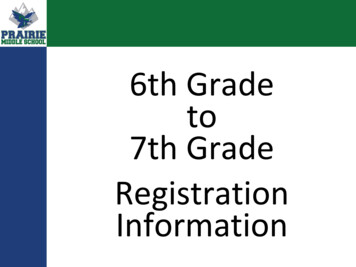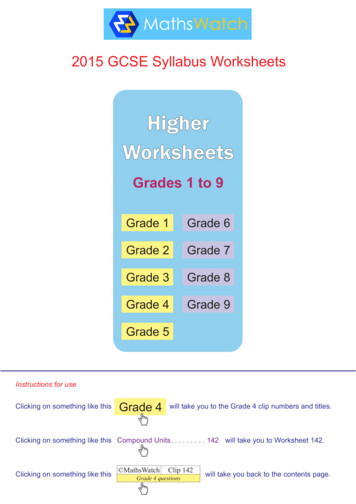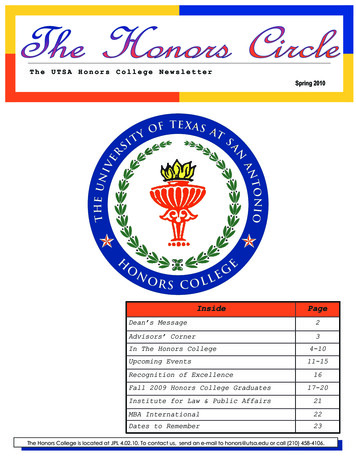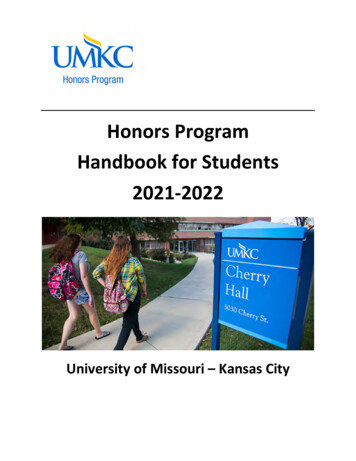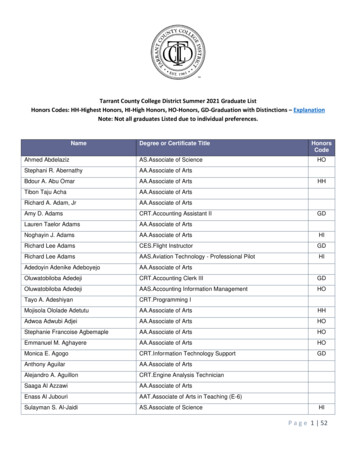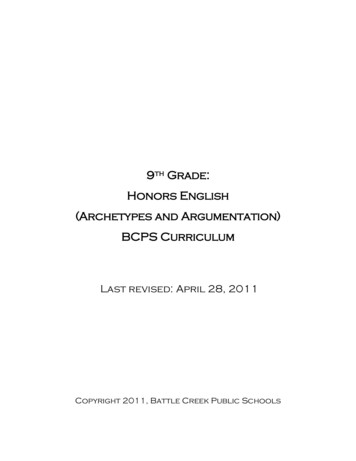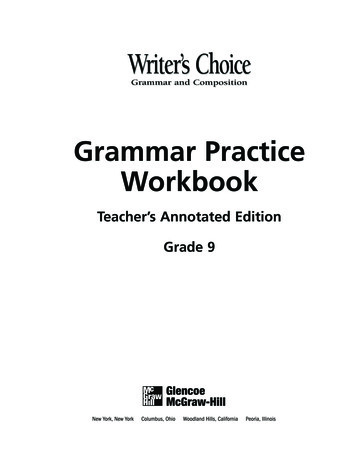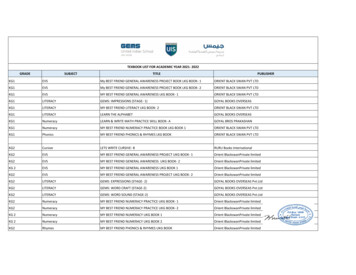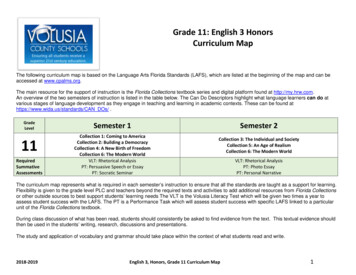
Transcription
Grade 11: English 3 HonorsCurriculum MapCOJNTY SCHOOLSlnsuring all students rece ive asuperior 21st century educ.-ition.The following curriculum map is based on the Language Arts Florida Standards (LAFS), which are listed at the beginning of the map and can beaccessed at www.cpalms.org.The main resource for the support of instruction is the Florida Collections textbook series and digital platform found at http://my.hrw.com.An overview of the two semesters of instruction is listed in the table below. The Can Do Descriptors highlight what language learners can do atvarious stages of language development as they engage in teaching and learning in academic contexts. These can be found athttps://www.wida.us/standards/CAN DOs/ .GradeLevelSemester 111Collection 1: Coming to AmericaCollection 2: Building a DemocracyCollection 4: A New Birth of FreedomCollection 6: The Modern WorldVLT: Rhetorical AnalysisPT: Persuasive Speech or EssayPT: Socratic SeminarRequiredSummativeAssessmentsSemester 2Collection 3: The Individual and SocietyCollection 5: An Age of RealismCollection 6: The Modern WorldVLT: Rhetorical AnalysisPT: Photo EssayPT: Personal NarrativeThe curriculum map represents what is required in each semester’s instruction to ensure that all the standards are taught as a support for learning.Flexibility is given to the grade level PLC and teachers beyond the required texts and activities to add additional resources from Florida Collectionsor other outside sources to best support students’ learning needs The VLT is the Volusia Literacy Test which will be given two times a year toassess student success with the LAFS. The PT is a Performance Task which will assess student success with specific LAFS linked to a particularunit of the Florida Collections textbook.During class discussion of what has been read, students should consistently be asked to find evidence from the text. This textual evidence shouldthen be used in the students’ writing, research, discussions and presentations.The study and application of vocabulary and grammar should take place within the context of what students read and write.2018-2019English 3, Honors, Grade 11 Curriculum Map1
Grade 11 Language Arts Florida StandardsYearlong Target Standards are bolded. These standards are highly assessed and represent major instructional shifts as required by the Language Arts FloridaStandards. Italicized standards are those that require instructional awareness and are woven into the reading and writing process; however, they are notformally assessed.Strand: READING STANDARDS FOR .4.10Cite strong and thorough textual evidence to support analysis of what the text says explicitly as well as inferences drawn from the text, includingdetermining where the text leaves matters uncertain.Determine two or more themes or central ideas of a text and analyze their development over the course of the text, including how they interact and buildon one another to produce a complex account; provide an objective summary of the text.Analyze the impact of the author’s choices regarding how to develop and relate elements of a story or drama (e.g., where a story is set, how the action isordered, how the characters are introduced and developed).Determine the meaning of words and phrases as they are used in the text, including figurative and connotative meanings; analyze the impact of specificword choices on meaning and tone, including words with multiple meanings or language that is particularly fresh, engaging, or beautiful. (IncludeShakespeare as well as other authors.)Analyze how an author’s choices concerning how to structure specific parts of a text (e.g., the choice of where to begin or end a story, the choice toprovide a comedic or tragic resolution) contribute to its overall structure and meaning as well as its aesthetic impact.Analyze a case in which grasping a point of view requires distinguishing what is directly stated in a text from what is really meant (e.g., satire, sarcasm,irony, or understatement).Analyze multiple interpretations of a story, drama, or poem (e.g., recorded or live production of a play or recorded novel or poetry), evaluating how eachversion interprets the source text. (Include at least one play by Shakespeare and one play by an American dramatist.)Demonstrate knowledge of eighteenth-, nineteenth- and early-twentieth-century foundational works of American literature, including how two or moretexts from the same period treat similar themes or topics.By the end of grade 11, read and comprehend literature, including stories, dramas, and poems, in the grades 11-CCR text complexity band proficiently, withscaffolding as needed at the high end of the range. By the end of grade 12, read and comprehend literature, including stories, dramas, and poems, at thehigh end of the grades 11-CCR text complexity band independently and proficiently.Strand: READING STANDARDS FOR INFORMATIONAL 2018-2019Cite strong and thorough textual evidence to support analysis of what the text says explicitly as well as inferences drawn from the text, includingdetermining where the text leaves matters uncertain.Determine two or more central ideas of a text and analyze their development over the course of the text, including how they interact and build on oneanother to provide a complex analysis; provide an objective summary of the text.Analyze a complex set of ideas or sequence of events and explain how specific individuals, ideas, or events interact and develop over the course of thetext.Determine the meaning of words and phrases as they are used in a text, including figurative, connotative, and technical meanings; analyze how anauthor uses and refines the meaning of a key term or terms over the course of a text (e.g., how Madison defines faction in Federalist No. 10).Analyze and evaluate the effectiveness of the structure an author uses in his or her exposition or argument, including whether the structure makes pointsclear, convincing, and engaging.Determine an author’s point of view or purpose in a text in which the rhetoric is particularly effective, analyzing how style and content contribute to thepower, persuasiveness or beauty of the text.English 3, Honors, Grade 11 Curriculum Map2
LAFS.1112.RI.3.7LAFS.1112.RI.3.8Integrate and evaluate multiple sources of information presented in different media or formats (e.g., visually, quantitatively) as well as in words in orderto address a question or solve a problem.Delineate and evaluate the reasoning in seminal U.S. texts, including the application of constitutional principles and use of legal reasoning (e.g., in U.S.Supreme Court majority opinions and dissents) and the premises, purposes, and arguments in works of public advocacy (e.g., The Federalist, presidentialaddresses).LAFS.1112.RI.3.9Analyze seventeenth-, eighteenth-, and nineteenth-century foundational U.S. documents of historical and literary significance (including The Declarationof Independence, the Preamble to the Constitution, the Bill of Rights, and Lincoln’s Second Inaugural Address) for their themes, purposes, and rhetoricalfeatures.LAFS.1112.RI.4.10By the end of grade 11, read and comprehend literary nonfiction in the grades 11-CCR text complexity band proficiently, with scaffolding as needed at thehigh end of the range. By the end of grade 12, read and comprehend literary nonfiction at the high end of the grades 11-CCR text complexity bandindependently and proficiently.Strand: WRITING W.1.1bLAFS.1112.W.1.1cWrite arguments to support claims in an analysis of substantive topics or texts, using valid reasoning and relevant and sufficient evidence.Introduce precise, knowledgeable claim(s), establish the significance of the claim(s), distinguish the claim(s) from alternate or opposing claims, and createan organization that logically sequences claim(s), counterclaims, reasons, and evidence.Develop claim(s) and counterclaims fairly and thoroughly, supplying the most relevant evidence for each while pointing out the strengths and limitationsof both in a manner that anticipates the audience’s knowledge level, concerns, values, and possible biases.Use words, phrases, and clauses as well as varied syntax to link the major sections of the text, create cohesion, and clarify the relationships betweenclaim(s) and reasons, between reasons and evidence, and between claim(s) and counterclaims.LAFS.1112.W.1.1dEstablish and maintain a formal style and objective tone while attending to the norms and conventions of the discipline in which they are writing.LAFS.1112.W.1.1eProvide a concluding statement or section that follows from and supports the argument .W.1.2bLAFS.1112.W.1.2cWrite informative/explanatory texts to examine and convey complex ideas, concepts, and information clearly and accurately through the effectiveselection, organization, and analysis of content.Introduce a topic; organize complex ideas, concepts, and information so that each new element builds on that which precedes it to create a unified whole;include formatting (e.g., headings), graphics (e.g., figures, tables), and multimedia when useful to aiding comprehension.Develop the topic thoroughly by selecting the most significant and relevant facts, extended definitions, concrete details, quotations, or other informationand examples appropriate to the audience’s knowledge of the topic.Use appropriate and varied transitions and syntax to link the major sections of the text, create cohesion, and clarify the relationships among complexideas and concepts.LAFS.1112.W.1.2dUse precise language, domain-specific vocabulary, and techniques such as metaphor, simile, and analogy to manage the complexity of the topic.LAFS.1112.W.1.2eEstablish and maintain a formal style and objective tone while attending to the norms and conventions of the discipline in which they are .1.3a2018-2019Provide a concluding statement or section that follows from and supports the information or explanation presented (e.g., articulating implications or thesignificance of the topic).Write narratives to develop real or imagined experiences or events using effective technique, well-chosen details, and well-structured eventsequences.Engage and orient the reader by setting out a problem, situation, or observation and its significance, establishing one or multiple point(s) of view, andintroducing a narrator and/or characters; create a smooth progression of experiences or events.English 3, Honors, Grade 11 Curriculum Map3
LAFS.1112.W.1.3bUse narrative techniques, such as dialogue, pacing, description, reflection, and multiple plot lines, to develop experiences, events, and/or characters.LAFS.1112.W.1.3cUse a variety of techniques to sequence events so that they build on one another to create a coherent whole and build toward a particular tone andoutcome (e.g., a sense of mystery, suspense, growth, or resolution).LAFS.1112.W.1.3dUse precise words and phrases, telling details, and sensory language to convey a vivid picture of the experiences, events, setting, and/or AFS.1112.W.4.10Provide a conclusion that follows from and reflects on what is experienced, observed, or resolved over the course of the narrative.Produce clear and coherent writing in which the development, organization, and style are appropriate to task, purpose, and audience. (Grade-specificexpectations for writing types are defined in standards 1–3 above.)Develop and strengthen writing as needed by planning, revising, editing, rewriting, or trying a new approach, focusing on addressing what is mostsignificant for a specific purpose and audience. (Editing for conventions should demonstrate command of Language standards 1–3 up to and includinggrades 1112)Use technology, including the Internet, to produce, publish, and update individual or shared writing products in response to ongoing feedback, includingnew arguments or information.Conduct short as well as more sustained research projects to answer a question (including a self-generated question) or solve a problem; narrow orbroaden the inquiry when appropriate; synthesize multiple sources on the subject, demonstrating understanding of the subject under investigation.Gather relevant information from multiple authoritative print and digital sources, using advanced searches effectively; assess the strengths and limitationsof each source in terms of the task, purpose, and audience; integrate information into the text selectively to maintain the flow of ideas, avoidingplagiarism and overreliance on any one source and following a standard format for citation.Draw evidence from literary or informational texts to support analysis, reflection, and research.Apply grades 11–12 Reading standards to literature (e.g., “Demonstrate knowledge of eighteenth-, nineteenth- and early-twentieth-century foundationalworks of American literature, including how two or more texts from the same period treat similar themes or topics”).Apply grades 11–12 Reading standards to literary nonfiction (e.g., “Delineate and evaluate the reasoning in seminal U.S. texts, including the application ofconstitutional principles and use of legal reasoning [e.g., in U.S. Supreme Court Case majority opinions and dissents] and the premises, purposes, andarguments in works of public advocacy [e.g., The Federalist, presidential addresses]”).Write routinely over extended time frames (time for research, reflection, and revision) and shorter time frames (a single sitting or a day or two) for a rangeof tasks, purposes, and audiences.Strand: SPEAKING AND LISTENING 12.SL.1.22018-2019Initiate and participate effectively in a range of collaborative discussions (one-on-one, in groups, and teacher-led) with diverse partners on grades 1112topics, texts, and issues, building on others’ ideas and expressing their own clearly and persuasively.Come to discussions prepared, having read and researched material under study; explicitly draw on that preparation by referring to evidence from textsand other research on the topic or issue to stimulate a thoughtful, well-reasoned exchange of ideas.Work with peers to promote civil, democratic discussions and decision-making, set clear goals and deadlines, and establish individual roles as needed.Propel conversations by posing and responding to questions that probe reasoning and evidence; ensure a hearing for a full range of positions on a topic orissue; clarify, verify, or challenge ideas and conclusions; and promote divergent and creative perspectives.Respond thoughtfully to diverse perspectives; synthesize comments, claims, and evidence made on all sides of an issue; resolve contradictions whenpossible; and determine what additional information or research is required to deepen the investigation or complete the task.Integrate multiple sources of information presented in diverse formats and media (e.g., visually, quantitatively, orally) in order to make informed decisionsand solve problems, evaluating the credibility and accuracy of each source and noting any discrepancies among the data.English 3, Honors, Grade 11 Curriculum Map4
FS.1112.SL.2.6Evaluate a speaker’s point of view, reasoning, and use of evidence and rhetoric, assessing the stance, premises, links among ideas, word choice, points ofemphasis, and tone used.Present information, findings, and supporting evidence, conveying a clear and distinct perspective, such that listeners can follow the line of reasoning,alternative or opposing perspectives are addressed, and the organization, development, substance, and style are appropriate to purpose, audience, and arange of formal and informal tasks.Make strategic use of digital media (e.g., textual, graphical, audio, visual, and interactive elements) in presentations to enhance understanding of findings,reasoning, and evidence and to add interest.Adapt speech to a variety of contexts and tasks, demonstrating command of formal English when indicated or appropriate. (See grades 1112 Languagestandards 1 and 3)Strand: LANGUAGE STANDARDSLAFS.1112.L.1.1Demonstrate command of the conventions of standard English grammar and usage when writing or speaking.LAFS.1112.L.1.1aApply the understanding that usage is a matter of convention, can change over time, and is sometimes contested.LAFS.1112.L.1.1bResolve issues of complex or contested usage, consulting references (e.g., Merriam-Webster’s Dictionary of English Usage, Garner’s Modern AmericanUsage) as needed.LAFS.1112.L.1.2Demonstrate command of the conventions of standard English capitalization, punctuation, and spelling when writing.LAFS.1112.L.1.2aObserve hyphenation conventions.LAFS.1112.L.1.2bSpell .L.3.4LAFS.1112.L.3.4aApply knowledge of language to understand how language functions in different contexts, to make effective choices for meaning or style, and tocomprehend more fully when reading or listening.Vary syntax for effect, consulting references (e.g., Tufte’s Artful Sentences) for guidance as needed; apply an understanding of syntax to the study ofcomplex texts when reading.Determine or clarify the meaning of unknown and multiple-meaning words and phrases based on grades 1112 reading and content, choosing flexibly froma range of strategies.Use context (e.g., the overall meaning of a sentence, paragraph, or text; a word’s position or function in a sentence) as a clue to the meaning of a word orphrase.LAFS.1112.L.3.4bIdentify and correctly use patterns of word changes that indicate different meanings or parts of speech (e.g., conceive, conception, conceivable).LAFS.1112.L.3.4cConsult general and specialized reference materials (e.g., dictionaries, glossaries, thesauruses), both print and digital, to find the pronunciation of a wordor determine or clarify its precise meaning, its part of speech, or its etymology, or its standard usage.LAFS.1112.L.3.4dVerify the preliminary determination of the meaning of a word or phrase (e.g., by checking the inferred meaning in context or in a dictionary).LAFS.1112.L.3.5Demonstrate understanding of figurative language, word relationships, and nuances in word meanings.LAFS.1112.L.3.5aInterpret figures of speech (e.g., hyperbole, paradox) in context and analyze their role in the text.LAFS.1112.L.3.5bAnalyze nuances in the meaning of words with similar denotations.LAFS.1112.L.3.6Acquire and use accurately general academic and domain-specific words and phrases, sufficient for reading, writing, speaking, and listening at the collegeand career readiness level; demonstrate independence in gathering vocabulary knowledge when considering a word or phrase important to comprehensionor expression.2018-2019English 3, Honors, Grade 11 Curriculum Map5
uarter 2Grade 7: M/J Language Arts 2 and M/J Language Arts 2 AdvancedReauired AssessmentsAssessed StandardsVlT: Areumentative Essa.v. (see Canvas)(Summativc)Assessment Window: XXXHow to Use Your Curriculum MapWS. 1.la : Write areumcnts to support daims with dear reasons and releYant evidence.LAFS.l.W.2.4: Produce dear and coherent writinc in vlt'uch the JevelOpment, orcanization, and swteare appropriate to task, pur . and audiel'Kt!:.LAFS. 3.9: Draw evidence from llttr1ry or informational texts to support anatysis, reftection, andRequired Assessments: These are the assessments you willgive during the quarter. With the exception of the ReadingDIA, each of these assessments will appear as a summativegrade in your gradebook. The Reading DIA will be entered asa formative grade.research.1 c , RL1.3: Analyze hO\v particular elemenu of a s,:ory or drama interaet.WS.7.RL2.S: Anatyze nuw a·- contributes10 its anina:. District Interim Assessment (DIA) of Readineor r.arratOtS In a text.2(Formative)Ass6sment Window:Bestitems/standards.a ume, plac or charam r and a historical,,. means of unc:terstanoirc now autnors of rw:tion use or alter historv.WS.7.RU.9: Compare and contrast a fiaccount of " .- ---uu-:). . 1.1.2: Determine two or more central ideas in a t fXt and analyze their dev pment c,ye., thepractice expectation is that teachersprovide feedback and review of DIALAFS.7.RL2.6: Analyze how an author develops and contrasts the points of view of different chacourse of the te t; provide an objectivt summ:sry of the te:rt.WS.7.Rl.1.3: Analyze the interactions twttn individuals, events, and ideas in teld.LAFS.7.Rl.2.6: Oe:temiine an authOf"'s point of view or i,url)OSe in a text ar.ct anaJyzedistircuishes his or her position from that of others.LAFS. l .1: Demonstrate command of the conventions of standard fnaTiSh arammar and usaae wheMnin,orspe:akina.LAFS.2.J: l.2: Demonstrate command of the conventions of standard fneTiSh capitarizatOO,nunctuation ands l lirwwhenwritin .hO 'i: "' Optional Assessment of standardsr.These are the standards that are included in theassessments.,,,,This is a mastery assessment of the focus standards for this nine weeks taken from the Collections end f-colt - ".'.:':'.'.'.'.::':: tApplicable Standards for Quarter 2 TextsWS.7.Rl.1.1: Ote several pieces of textual evidence to support analysis of what tv:t says expicitfy as weU as inferences drawn from the 1extLAFS.7.RL2.4: Determine the mean In, of words ar.ct i,hrases as they are used in a text, lndudlne fieumive and connotative me anines; anaty?e tl\e impact ofrhymes and other r tit.ions of sounds (e .e-, alliteration) on a specific v«se or stanza of a m or section of a story or drama.LAFS.7,RL2.4: :ermine the meanlne of words and pr-.rases as tP'leY are use-cl in a text, lndud1rc fieurative, connotative, and technical me, , - - - - - - - - - - - - - - - - - - - - - - - -JI Applicable Standards are skills-- . .students will use with every text. - I I,The Learning Targets should be clearlydisplayed to students during the teachingof the required Text/Text Set.The Text/Text Set is identified. If thetext is not in Collections, it isavailable on Canvas.The Suggested Pacing is therecommended amount of timeyou should plan to spend on thetext and standards-aligned tasks.The Resou r,ces in du dereao mm e nd ed mate rials fromCollections a nd othe r outs ideso urces for differentiat inginstruction aligned t o th eFocus Standa rds.Resources Abbreviation KeyBio- BiographyCR- Close ReaderCRA- Close Read ApplicationCRS- Close Read ScreencastIGO- Interactive Graphic OrganizerIWL- Interactive Whiteboard LessonLUT- Level Up TutorialMWS- myWriteSmart Lesson-An Optional Assessment ofStandards taken from theCollections printable end ofcollection assessments is availableon Canvas for each quarter.The Curriculum Focus describes theoverall focus of the text or text set.Quarter 1 - Curri culum Focus: DeterminiAssignments and Resourcesearning Target: Students willprovide a statement of a themeor central idea of the text.Learning Target : Students willprovide an analysis of thedevelopment of the theme overthe cou rse of the text. (RL.1 .2 )Ana lyze the Text, p. 214,Questions 1, 3 - - - - - - - - - - - - - - - - -- Suggested Common FormativeAssessment: Analyze the Text, p. 214,Question 4 AND Performance Task,Writing Activity: Analysis, p.Focus Standards and FSA Item SpecsThe RequiredAssignments will helpstudents master the focusstandards listed.used in a text, including figurative and connotative meani ngs; analyze theimpact of rhymes and other repetitions of sounds on a specific verse orstanza of a poem or section of a story or drama .FSA Sta ndard Specifications: The item may ask the student to determinea theme or centra l idea from a sef the passage or from the entire ,.-.- - - - - - - - - - - - - - - - .passage. The item may refer to themes an c'deas that are explicit FSA. Item Specificationor implicit in the text. Items may ask the student to summinfo rm alto 111 is providedof the text.for each lea rning t a rget.The Suggested Common Formative Assessment is closelyaligned with the Focus Standards and Learning Target. ThisThe Suggested Learning Strategy is a studentassignment should be a formative grade in your Gradebook. Asengagement strategy that pairs well with thesuch, it will also serve as a reliable data point for PLCCommon Formative Assessment.discussion.English 3, Honors, Grade 11 Curricp
Semester 1Grade 11: English 3 HonorsRequired AssessmentsAssessed Standards VLT 1: Rhetorical AnalysisAssessment Window: November 26 – December 20(Summative) Performance Task: Present a Persuasive Speech, p. 323(Summative)Teacher may vary topic (e.g., identity, foundational values,etc.). This assessment may also be done as a written script orformal argument. Literary Analysis Essay (based on The Crucible)Students should develop original theses/prompts/topics.Sample thesis ideas: the importance of reputation, modernrelevance of The Crucible, meaning and significance the title,irony’s role in developing the plot, or psychoanalysis of one ofthe characters, etc.LAFS.1112.W.1.1: Write arguments to support claims in an analysis of substantivetopics or texts, using valid reasoning and relevant and sufficient evidence.LAFS.1112.W.2.4: Produce clear and coherent writing in which the development,organization, and style are appropriate to task, purpose, and audience.LAFS.1112.W.3.9: Draw evidence from literary or informational texts to supportanalysis, reflection, and research.LAFS.1112.SL.1.2: Integrate multiple sources of information presented in diverseformats and media in order to make informed decisions and solve problems,evaluating the credibility and accuracy of each source and noting any discrepanciesamong the data.LAFS.1112.SL.2.4: Present information, findings, and supporting evidence, conveying aclear and distinct perspective, such that listeners can follow the line of reasoning,alternative or opposing perspectives are addressed, and the organization,development, substance, and style are appropriate to purpose, audience, and a rangeof formal and informal tasks.LAFS.1112.SL.1.1: Initiate and participate effectively in a range of collaborativediscussions (one-on-one, in groups, and teacher-led) with diverse partners on grades1112 topics, texts, and issues, building on others’ ideas and expressing their ownclearly and persuasively.LAFS.1112.SL.1.3: Evaluate a speaker’s point of view, reasoning, and use of evidenceand rhetoric, assessing the stance, premises, links among ideas, word choice, points ofemphasis, and tone used. Optional Assessments of Standards- Quarter 1 Optional Assessments of Standards- Quarter 2These are mastery assessments of the focus standards for each nine weeks taken from the Collections end-of-collection printable assessments.Applicable Standards for All Semester 1 TextsLAFS.1112.RL1.1: Cite strong and thorough textual evidence to support analysis of what the text says explicitly as well as inferences drawn from the text,including determining where the text leaves matters uncertain.LAFS.1112.RI.1.1: Cite strong and thorough textual evidence to support analysis of what the text says explicitly as well as inferences drawn from the text,including determining where the text leaves matters uncertain.LAFS.1112.W.1.1a-e: Write arguments to support claims in an analysis of substantive topics or texts, using valid reasoning and relevant and sufficient evidence.LAFS.1112.W.3.9: Draw evidence from literary or informational texts to support analysis, reflection, and research.LAFS.1112.SL.1.1a: Come to discussions prepared, having read and researched material under study; explicitly draw on that preparation by referring to evidencefrom texts and other research on the topic or issue to stimulate a thoughtful, well-reasoned exchange of ideas.2018-2019English 3, Honors, Grade 11 Curriculum Map7
Semester 2 - Curriculum Focus: The Structure and Purpose of ArgumentRequired Texts and TargetsText:“Blaxicans and Other ReinventedAmericans,” p. 87Learning Target: Students willprovide an analysis and evaluationof the effectiveness of thestructure an author uses in his orher exposition or argument thatincludes whether the structuremakes points clear, convincing andengaging. (RI.2.5)Learning Target: Students willprovide a determination of anauthor’s point of view or purposein a text in which the rhetoric isparticularly effective. (RI.2.6)Suggested pacing: 1 weekAssignments and ResourcesAnalyze and Evaluate Structure: Arguments, p.93Have students complete the activity from thewrap around in the Teacher Edition, p. 93Determine Author’s Purpose: Irony, Completethe Ask Students activity in the Teacher Edition,p. 93 after reading.FSA Standard Specifications: Items may be overarching questionsabout the structure/development of the entire text or aboutspecific structural elements. Items should ask the student toAnalyze the Text, p. 94, Questions 1, 3, 5, 7, 8analyze the author’s ideas or claims in the context of particularstructural decisions made by the author. However, a two-partitem may ask the student to determine the structure used andthen analyze how it develops the ideas or claims. RI.2.5)Suggested Common Formative Assessment:Items may ask the student to determine the point of view orPerformance Task Writing Activity: Evaluation, purpose in a text and to analyze how it is advanced or conveyedp. 94by the author. Items should focus on meaningful rhetoricaldevices that specifically advan
Grade 11: English 3 Honors Curriculum Map The following curriculum map is based on the Language Arts Florida Standards (LAFS), which are listed at the beginning of the map and can be accessed at . www.cpalms.org. The main resource for the support of instruction is the . Florida Collections . textbook series and digital platform found at

